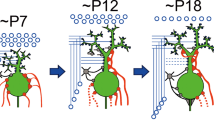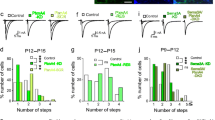Abstract
During postnatal development of the cerebellum, the number of climbing fibers that innervate individual Purkinje cells decreases from many to one. This is one of the most characterized models of activity-dependent refinement of synaptic circuitry in the mammalian brain. As surplus climbing fibers are eliminated, subcellular location of climbing fiber terminals moves from the soma to the dendrites of Purkinje cells. The role of this dendritic translocation in climbing fiber elimination has been under debate for a long time, but recent studies have significantly changed the view. Traditionally, dendritic translocation was considered neither sufficient nor necessary for climbing fiber elimination, but experimental evidence obtained over the past 5 years indicates crucial roles of dendritic translocation for selectively maintaining one fiber while removing all the others. Here, I provide an overview of (i) several key findings that have contributed for developing the traditional and current views of dendritic translocation, (ii) how our novel experimental approach supports the current view, and (iii) a remaining question that is yet to be answered.

Similar content being viewed by others
References
Sugihara I, Wu H, Shinoda Y. Morphology of single olivocerebellar axons labeled with biotinylated dextran amine in the rat. J Comp Neurol. 1999;414(2):131–48.
Crepel F, Mariani J, Delhaye-Bouchaud N. Evidence for a multiple innervation of Purkinje cells by climbing fibers in the immature rat cerebellum. J Neurobiol. 1976;7(6):567–78.
Hashimoto K, Kano M. Synapse elimination in the developing cerebellum. Cell Mol Life Sci. 2013;70(24):4667–80.
Katz LC, Shatz CJ. Synaptic activity and the construction of cortical circuits. Science. 1996;274(5290):1133–8.
Lichtman JW, Colman H. Synapse elimination and indelible memory. Neuron. 2000;25(2):269–78.
Palay S, Chan-Palay V. Cerebellar cortex: Cytology and organizaion. New York: Springer; 1974.
Hashimoto K, Ichikawa R, Kitamura K, Watanabe M, Kano M. Translocation of a “winner” climbing fiber to the Purkinje cell dendrite and subsequent elimination of “losers” from the soma in developing cerebellum. Neuron. 2009;63(1):106–18.
Sotelo C. Cerebellar synaptogenesis: What we can learn from mutant mice. J Exp Biol. 1990;153:225–49.
Crepel F, Delhaye-Bouchaud N, Guastavino JM, Sampaio I. Multiple innervation of cerebellar Purkinje cells by climbing fibres in staggerer mutant mouse. Nature. 1980;283(5746):483–4.
Mariani J, Changeux JP. Multiple innervation of Purkinje cells by climbing fibers in the cerebellum of the adult staggerer mutant mouse. J Neurobiol. 1980;11(1):41–50.
Guenet JL, Sotelo C, Mariani J. Hyperspiny Purkinje cell, a new neurological mutation in the mouse. J Hered. 1983;74(2):105–8.
Scelfo B, Strata P, Knopfel T. Sodium imaging of climbing fiber innervation fields in developing mouse Purkinje cells. J Neurophysiol. 2003;89(5):2555–63.
Carrillo J, Nishiyama N, Nishiyama H. Dendritic translocation establishes the winner in cerebellar climbing fiber synapse elimination. J Neurosci. 2013;33(18):7641–53.
Mikuni T, Uesaka N, Okuno H, Hirai H, Deisseroth K, Bito H, et al. Arc/Arg3.1 is a postsynaptic mediator of activity-dependent synapse elimination in the developing cerebellum. Neuron. 2013;78(6):1024–35.
Uesaka N, Uchigashima M, Mikuni T, Nakazawa T, Nakao H, Hirai H, et al. Retrograde semaphorin signaling regulates synapse elimination in the developing mouse brain. Science. 2014;344(6187):1020–3.
Acknowledgments
This work was supported by National Institutes of Health Grant NS073919.
Conflict of Interest
The author declares no competing financial interests
Author information
Authors and Affiliations
Corresponding author
Rights and permissions
About this article
Cite this article
Nishiyama, H. Dendritic Translocation of Climbing Fibers: A New Face of Old Phenomenon. Cerebellum 14, 1–3 (2015). https://doi.org/10.1007/s12311-014-0614-z
Published:
Issue Date:
DOI: https://doi.org/10.1007/s12311-014-0614-z




